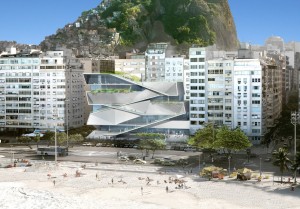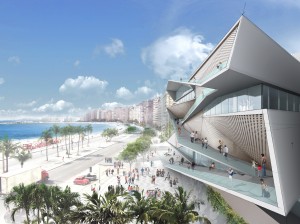MIS Set to Replace Club Help in Copacabana
By Katya Gubarev, Contributing Reporter
RIO DE JANEIRO, BRAZIL – After more than 25 years, Help Discotheque, a notorious symbol of prostitution in Rio, closed its doors after the Prefeitura (local government) initiated the process in 2008. The prime location along Copacabana Beach will transform into a new landmark, the Museum of Image and Sound (MIS), and planned to be completed in the end of 2012.

The planned Museum of Image and Sound (MIS), image provided by Secretaria de Cultura.
Budgeted at R$70 million, the project is a partnership of state government with the Roberto Marinho Foundation. The demolition is expected to be finished in March 2011, clearing the area of 7,000 square meters on Avenida Atlantica.
The design is by the American architect Elizabeth Diller, whose concept is a reproduction of the famous Copacabana sidewalk with its alternating black and white waves in a vertical version of a LEED (Leadership in Energy & Environmental Design) standard building.
The first Museum of Image and Sound of Rio de Janeiro (RJ-MIS) was inaugurated on September 3, 1965, as part of the fourth centenary celebration of the city. Currently, the MIS has two headquarters: one in Lapa, where it houses the collection of text and audio, including the collection of the National Radio, and the other at Praça XV, where there are iconography, video and many newspaper exhibits.
The new headquarters in Copacabana will have permanent showrooms, temporary spaces for research, classrooms for teaching activities, a theater with 300 seats, a shop, a cafeteria, a panoramic restaurant, a bar with a terrace, a piano bar, and an observatory on the seventh floor.
Hugo Sukman, the curator of the future museum, says that it will be divided into different levels. The first two levels will be ESPÍRITO CARIOCA (Carioca Spirit), dedicated to city’s festivals and the Carnival and MÚSICA (Music), illustrating the history of samba, choro and bossa nova and their performers.

Museum of Image and Sound (MIS), image provided by Secretaria de Cultura.
The floor FELIZES TRÓPICOS (Happy Tropics) will display the Carioca way of life such as the production of soap operas and film, and museum of Carmen Miranda, now located in Flamengo. The final levels will be É SUL, É SAL, É SOL (Is South, Is Salt, Is Sun) dealing with the city’s link with nature, and NOITES CARIOCAS (Carioca Nights), showing the nightlife flavors, from samba to funk parties.
“In this new headquarters we will re-conceptualize the MIS, which will become a new tourist attraction. The collection, that is one of the most important in the state to show the history of Rio, will be preserved for the public, both tourists and locals, who will know more about the city’s culture, music, carnival,” confirms Adriana Rattes, Secretary of State for Culture. “This will be a symbol of Rio de Janeiro.”
While the closing of Help was certainly controversial, local residents seem generally pleased with the plan. “I am glad that they’re building a museum here,” shares Marcia Silva, a resident of Copacabana, “because right now there are only clubs and restaurants in the area.”
As Copacabana prepares for it’s role in the 2016 Olympic Games, which will be centered around Maracanã stadium, and also take place in Deodoro and Barra de Tijuca, certainly many more renovation projects are expected in the next five years.

mj says:
ReplyDeleteJanuary 30, 2011 at 9:12 AM
Copacabana is much better without help. There is less crime, less drugs, and fewer kids begging tourist. There was a big element of Prostitution going on in around help. Most of these young ladies, not all were doing drugs. That brought the dealers, that brought the gansters and the bandits. All following the trail of money. I spend a lot of time there and I have seen the transition. In life, we need to focus on progress and change. Sometimes, change is painful but a nescessary evil for progress. A lot of (Gringoes) – tourist complain there are no dance clubs. They really mean, there is no great place to dance and pick up easy women. I will simply refer them to Lapa, or Leblon as well as Barra if they are looking for a nice area to Party. I like the new peaceful Copacabana. I am looking forward to the MIS completion. We need to be exposed to more of the Brazilian culture.
MJ
Only an interloper would think that Copacabana is better off with the closing of Club HELP. The area around Rua Miguel Lemos, where HELP used to be turns into a ghost town once the sun goes down. The neighborhood lost its power base. Apartment rentals are down, there are fewer people visiting area restaurants. Meia Pataca would have had to close its doors if it weren't for the overflow from Rio Othon Palace Hotel, next door. All of the negative elements that once plagued the neighborhood, which is a policing matter, has shifted down to the area surrounding the Balcony. Just saying that things have improved does not make it so.
ReplyDeleteI AGREE WITH YOU
ReplyDeleteSorry to hear about HELP Discoteca. It was an institution, right next to Meia Pataca, which serves a great breakfast and chicken noodle soup. Spent hours there, but never went into HELP because of the hookers. I refuse to pay for sex. And the SDS scare the hell out of me, even with a rubber. I wonder how Blame It on Rio, a little travel agent on the same street that the Rio Othon Palace is located is doing? Where did all the Chicas go?
ReplyDeletei agree
ReplyDelete